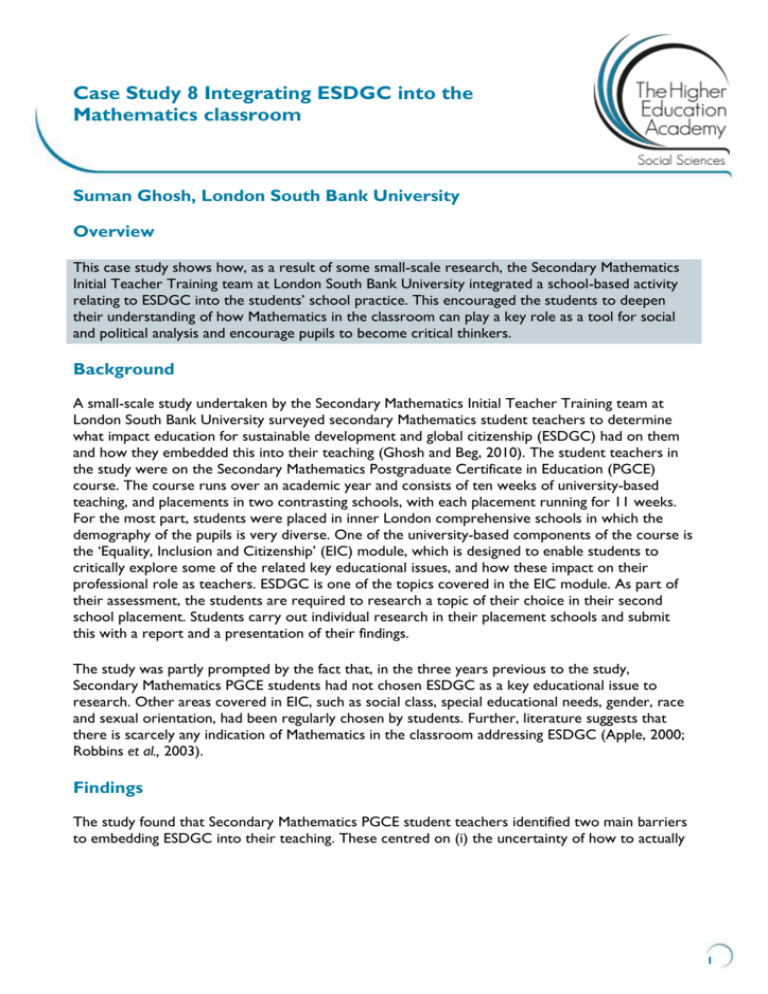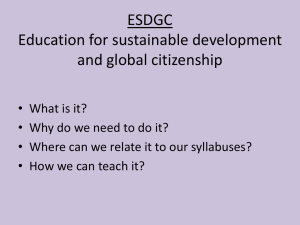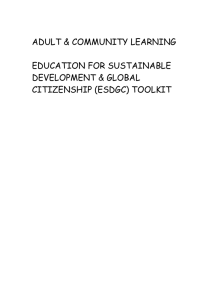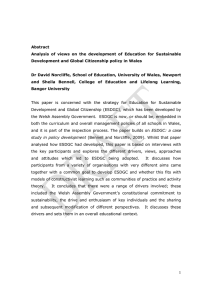Mathematics classroom - Higher Education Academy
advertisement

Case Study 8 Integrating ESDGC into the Mathematics classroom Suman Ghosh, London South Bank University Overview This case study shows how, as a result of some small-scale research, the Secondary Mathematics Initial Teacher Training team at London South Bank University integrated a school-based activity relating to ESDGC into the students’ school practice. This encouraged the students to deepen their understanding of how Mathematics in the classroom can play a key role as a tool for social and political analysis and encourage pupils to become critical thinkers. Background A small-scale study undertaken by the Secondary Mathematics Initial Teacher Training team at London South Bank University surveyed secondary Mathematics student teachers to determine what impact education for sustainable development and global citizenship (ESDGC) had on them and how they embedded this into their teaching (Ghosh and Beg, 2010). The student teachers in the study were on the Secondary Mathematics Postgraduate Certificate in Education (PGCE) course. The course runs over an academic year and consists of ten weeks of university-based teaching, and placements in two contrasting schools, with each placement running for 11 weeks. For the most part, students were placed in inner London comprehensive schools in which the demography of the pupils is very diverse. One of the university-based components of the course is the ‘Equality, Inclusion and Citizenship’ (EIC) module, which is designed to enable students to critically explore some of the related key educational issues, and how these impact on their professional role as teachers. ESDGC is one of the topics covered in the EIC module. As part of their assessment, the students are required to research a topic of their choice in their second school placement. Students carry out individual research in their placement schools and submit this with a report and a presentation of their findings. The study was partly prompted by the fact that, in the three years previous to the study, Secondary Mathematics PGCE students had not chosen ESDGC as a key educational issue to research. Other areas covered in EIC, such as social class, special educational needs, gender, race and sexual orientation, had been regularly chosen by students. Further, literature suggests that there is scarcely any indication of Mathematics in the classroom addressing ESDGC (Apple, 2000; Robbins et al., 2003). Findings The study found that Secondary Mathematics PGCE student teachers identified two main barriers to embedding ESDGC into their teaching. These centred on (i) the uncertainty of how to actually 1 include this in their Mathematics teaching, and (ii) dealing with the constraints of the Mathematics curriculum. A follow-up study (Ghosh and Beg, 2011) investigated the mathematical resources available in secondary school Mathematics classrooms and the extent to which they encourage the embedding of ESDGC in teaching. This case study summarises these findings and presents some of the good practice which resulted from the Secondary Mathematics Education team using directed activities in order to encourage their students to integrate ESDGC into their lessons. Analysis of Mathematics classroom resources A wide range of textbooks and worksheets were used at key stage 3 within departments and by the student teachers. Ten Ticks – a set of commercially produced worksheets – were used by many of the students in both key stages 3 and 4. However, at key stage 4, there was a narrower range of textbooks used, and these were aligned to the GCSEawarding bodies used by the schools. The textbooks, then, were designed to teach to the requirements of the awarding bodies. A very cursory glance at the Ten Ticks worksheets showed a series of level-based consolidation mathematical exercises, games and activities. The use of comic figures appears to soften the endless rows of questions, very few of which are contextualised and, from the sample taken, none of which had any content referring to ESDGC. Two Edexcel higher GCSE textbooks were analysed in an attempt to identify the extent to which issues around ESDGC were explicitly included in examples, questions and exercises. The ‘Heinemann Edexcel GCSE Mathematics Higher’ textbook – widely used in secondary schools – had a clear layout of mathematical explanations of the topics followed by a series of exercises, interspersed with some small coloured drawings and photographs. Written and endorsed by one of the public examination bodies, it demonstrates little or no content to encourage pupils to critically reflect on issues of sustainability or global issues, when there are obvious opportunities to do so. The following example serves as an example: describe questions taken from the book. In one question pupils were asked to complete a two-way table based on the results of the survey of 100 people, asking them which type of tea they buy. The categories given are tea bags, packet tea and instant tea. Ironically, without any mention of fair trade tea in the question, a token gesture towards ESDGC is made by adding a picture of a tea plantation worker next to the question, and a statement underneath it reading: ‘Sales of fair trade tea are increasing in Britain. Fair trade initiatives should ensure workers earn fair wages’. There was no question relating to this statement, or any other reference to fair trade in the question. Further examples include a percentages question showing a small picture of a boy holding a ball, which bore no relation to any of the questions used; and a fractions question with a picture of people on a rollercoaster and a picture of planet Earth next to some questions on standard form. These small images hardly register or make an impact in terms of contextualising the mathematics, and certainly would not engender discussion. Overall the (albeit limited) analysis of the resources revealed no reference to any issues around ESDGC. Therefore, the Secondary Mathematics PGCE students had very little exposure to issues of sustainability and global citizenship in the resources they were using. 2 ESDGC in the Mathematics classroom In order to encourage the integration of ESDGC into the Mathematics classroom, this theme runs through many of the university-based sessions for the Secondary Mathematics PGCE students. The student teachers are also required to maintain a reflective journal – the school experience learning journal – throughout their school placement. This includes weekly, directed activities that student teachers are required to undertake. As a result of the findings from the study, the Secondary Mathematics Education team added an activity which requires the students to investigate the school’s policy on ESDGC, and how the school and the Mathematics department address this. The directed activity also requires the students to plan and deliver a lesson that addresses ESDGC. This goes some way to raising awareness of these issues in a mathematical context, and the following examples demonstrate that the student teachers produce some innovative lessons: This goes some way to raising awareness of these issues in a mathematical context, and the following examples demonstrate that the student teachers produce some innovative lessons: i. ii. iii. iv. v. discussing data relating to the death penalty as a deterrent for violent crime in America. The statistical data included the number of murders, the number of people sentenced to death and the actual number of people executed; a visual representation of six billion and the proportion who live on a dollar or less per day. This student teacher also carried out an activity of dividing resources as a third world village would; one student teacher worked in a school that had close links with schools in China, Bangladesh and Tanzania. During ‘extended talent days’, the Mathematics department arranged activities linked to these schools, for example, scale drawings of iconic buildings in each of the countries; showng the change in world map proportion according to population/unemployment, generating discussion of this and providing various statistical data related to the population of the continents in order for pupils to answer related Mathematics questions; deciding how the price of a banana should be distributed between the retailer, the carriers, the factory workers, the plantation owners and the plantation workers. It was evident from the quality of some of these lessons that, once ideas of ESDGC had been discussed with the Mathematics student teachers, and they had been prompted to integrate this into their teaching, lessons had been designed that could potentially encourage pupils to critically think about ESDGC in a mathematical context. 3 References Apple, M. W. (2000) Mathematics reform through conservative modernization? Standards, markets and inequality in education. In Boaler, J. (ed.) Multiple perspectives on mathematics teaching and learning. Westport, CT: Ablex. Ghosh, S. and Beg, S. (2010) What impact does 'education for global citizenship' and 'education for sustainability' have on trainee teachers? Education for Hope: the impact of ESD/GC on the well being of teachers and young people (TEESnet 2010 conference proceedings, 88-95). Ghosh, S. and Beg, S. (2011) Education for Sustainable Development/Global Citizenship in Mathematics Teaching. Building Capacity for ESD/GC in times of change (TEESnet 2011 conference proceedings, 64-70). Robbins, M., Francis, L. J. and Elliot, E. (2003) Attitude toward education for global citizenship among student teachers. Research in Education. 69, 93-98. 4










